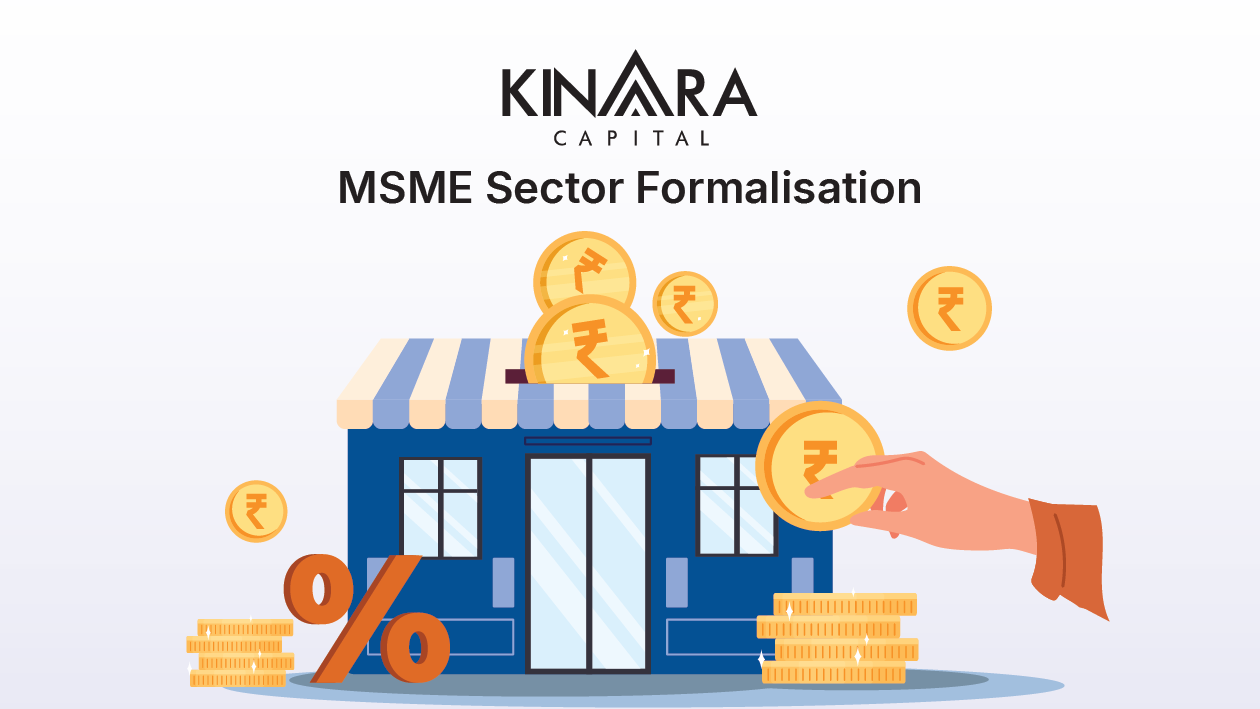
The MSME sector accounts for a more significant portion of India’s exports and is a more significant contributor to the GDP of the nation. However, there are several bottlenecks, such as lack of access to credits, physical infrastructure constraints, reluctance to adopt new technologies, and many more, which prevent the creation of a supportive business environment for the sector’s advancement. One important strategy adopted by the Ministry of MSME to address this problem is to formalise the sector by recognising more unrecognised MSME businesses. It helped many uncategorised industries to come together and access more resources.
Formalisation was a great strategy which helped numerous MSME entrepreneurs upgrade their dream businesses. The first step or the biggest ambition of the MSME ministry is to identify the micro, small and medium entrepreneurs and bring them under a formal structure, said by the MSME Ministry Secretary B.B Swain at an industry interaction event, which is organised online by Financial Express. This initiative helped to bring the MSME businesses that operated informally into the limelight and register them formally to get all the benefits and various schemes that the Ministry of MSME offers.
The Udyam Registration Portal is another brilliant initiative that was introduced by the Ministry of MSME on July 1, 2020, to ease the registration process. It facilitates the formal registration of informally operating MSMEs through a digital, paperless process. The Udyam portal has crossed more than 4 crore registrations in two years. As per the recent report of the Ministry of MSME, the total micro, small, and medium enterprises registered on the Udyam portal are around 1 crore, which employs 70.84% of people, and 10.2% of the crore are women. This will bring more transparency to the distribution of government aid to the right people without any delay.
Another major concrete step the Government of India took to uplift and empower the MSME sector was clearing the delayed payment. Delayed payment is one of the biggest bottlenecks MSMEs face from the entities they work for. In a speech, Union Minister Nirmala Sitharaman shared the steps the Government has initiated to clear the pending payments from the Central and State Governments, Central and state-owned organisations, and private limited industries to support the growth of the MSME sector.
“We have pressed the private companies to clear the payment cycles of MSME businesses within 45 days. For the first time, incentive announcements of Rs 6000 crore were made. The RAMP scheme has benefited the exporters. Around 18,000 MSMEs have received digital transfers totalling more than Rs. 500 crores to help the firms grow under the Self Reliant India fund,” she said.
Digitisation of the MSME sector is a cognizant approach adopted by the Government of India to lead the country toward a digital economy. In the past or before the start of digital lending in MSME, obtaining a loan for a small and medium-sized business, especially if it’s coming from an unrecognised sector, was a mammoth task. This caused many delays in the process and impacted the organisation’s productivity. This issue was resolved with the introduction of digital lending.
Supply chain financing (SCF) has emerged as an effective solution to address the pain points of MSMEs, providing them access to funding to alleviate their working capital challenges at competitive interest rates. In this process, buyers typically initiate financing requests, and sellers receive upfront payments from banks and NBFCs against their invoices. While SCF has existed formally and informally for decades in India, digitisation has significantly enhanced its reach and impact.
The Peer-to-Peer (P2P) lending model, a highly successful alternative financing method globally, is also gaining traction in India. Borrowers are onboarded and verified on P2P lending platforms, where financers can review detailed borrower information before extending loans. This bidding process creates an open marketplace for all entities. To support small businesses and strengthen digital ecosystems, the Reserve Bank of India (RBI) introduced the Trade Receivables and Discounting System (TReDS) and small finance banks, promoting the formalisation of digital lending and enhancing MSME lending opportunities.
As digital lending has altered both the demand and supply side, the lack of a digital footprint, official documentation, and properties owned by an MSME owner is not a barrier. By utilising data analytics and AI, digital lenders evaluate a borrower’s creditworthiness using data mapped from economic behavior, payment history, and other previous transactions. These cutting-edge methods make for a more inclusive lending ecosystem.
The digital platform and infrastructure enabled small business entrepreneurs to formalise and digitalise their businesses and take advantage of the Udyam portal and the various schemes provided by the MSME ministry and the Government of India.
Micro, Small, and Medium-scale Enterprises (MSMEs) in India face numerous challenges, including issues with formalisation and limited access to finance, markets, technology, and digitalisation. According to the Economic Survey, these obstacles hinder their economic growth and contribution.
According to the Ministry of Statistics and Programme Implementation, MSMEs contributed 35.4% to India’s manufacturing output in FY22. Furthermore, the Directorate General of Commercial Intelligence and Statistics (DGCIS) noted that MSME-specific products comprised 45.7% of India’s exports in FY24. Despite these substantial contributions, MSMEs still need help with formalisation and accessing credit.
The 73rd National Sample Survey unveiled 63 million unincorporated, non-agricultural entities in FY16, predominantly micro-enterprises. These businesses, lacking PAN or GST registrations, were excluded from government support systems like the Udyam Registration Portal. To bridge this gap, the Ministry of MSME, in collaboration with SIDBI, introduced the Udyam Assist Platform in 2023. As of June 2024, this platform has onboarded 1.86 crore informal micro-enterprises, while over 4.5 crore entities are now registered on both URP and UAP.
MSME lending is a critical area where policy intentions have not yielded the desired outcomes yet. Access to credit remains a significant challenge for MSMEs, primarily due to their lack of formalisation and credit history. The Ministry has called for more robust support from India’s financial sector to enhance capital formation and promote trade, business, and investments in MSMEs. Introducing new technologies, such as the Open Credit Enablement Network (OCEN), is expected to facilitate smoother credit access for MSMEs, boosting credit flow and aiding their financial inclusion.
Despite the progress, MSME challenges persist in infrastructure, market access, and skilling. Infrastructural bottlenecks and the lack of access to modern technology impede productivity and competitiveness. Moreover, inadequate skilling and training programmes further exacerbate these challenges, limiting the growth potential of MSMEs.
The shift that digital lending has brought about is altering how MSME financing is perceived. What was formerly a difficult and time-consuming activity is now a readily available business decision. It is beneficial for the lending environment, MSME borrowers, and the Indian economy as a whole to empower the underserved through capital inclusion.
The government is establishing a better environment with ease of doing business by removing the bottlenecks and organising the MSME sector. The MSME sector is primarily run by people of the lower or middle classes who lack access to the necessary resources, credit, and knowledge of the most recent technological advancements. As a result, the ease of doing business is crucial.
Formalisation can create a better industrial base, spread awareness about rights and opportunities, increase the employment rate among the rural and semi-urban population, and can reduce import dependency, and increase the export potential by increasing productivity.
Kinara Capital has helped many MSME entrepreneurs to upgrade their dream businesses by holding their hands and fulfilling their funding needs. Any registered small business owners who want to establish their business can visit Kinara’s website or myKinara digital app to check the eligibility of their enterprise through a 1-minute eligibility test. An eligible MSME entrepreneur can apply for a business loan and get the amount credited to their bank account digitally.
The formalisation of MSMEs enhances access to credit, markets, and government schemes, fostering growth and stability.
Formalisation reduces bottlenecks by improving transparency and regulatory compliance and enabling smoother financial and support services access.
Formalised MSMEs contribute to economic growth by increasing tax revenues, creating jobs, and promoting innovation and competitiveness.
Formalisation improves the lending capacity of financial institutions by providing reliable financial records, reducing risk, and enabling better credit assessment.
Streamlining lending processes provides MSMEs quicker access to funds, reduces borrowing costs, and supports business expansion and sustainability.
